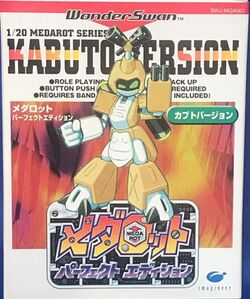Medarot Perfect Edition
| Medarot Perfect Edition メダロット パーフェクトエディショ | |

| |
| Genre | RPG |
|---|---|
| Platform | WonderSwan |
| Developer | TOSE |
| Publisher | Imagineer |
| Release Date | May 4, 1999 |
Medarot Perfect Edition is a RPG game released for the WonderSwan handheld in 1999 and the first game in the Medarot series to be released on a non-Nintendo system. It is a faithful remake of Medarot 1, keeping most of the contents and the game balance the same but making a number of changes and additions to make for a smoother play experience and flesh out the story.
Many of the features introduced in Perfect Edition such as dialogue portraits, separate health point display for a Medarot's parts, and dialogue for the protagonist's starter Medarot would become mainstay of the series.
Selection of Medarots
- Main article: Medarots in Medarot 1
The game features the same roster as Medarot 1, meaning it contains 60 different Medarots (49 male, 11 female), for a total of 240 collectable parts. Due to the lack of companion Parts Collection title, many Medarots that were missable or could only be partially assembled without trading are more easily available. All Medarots have the same stats they did in the original game.
List of changes
Interface
- An opening FMV has been added. It is different between versions.
- The playfield is in widescreen to match the WonderSwan's aspect ratio
- All Medarot sprites have been entirely redrawn and better match their official artwork appearance
- Most story-critical characters and many NPCs now have dialogue portraits.
- The Medarot Assembly screen has been overhauled and allows comparisons of stats between individual parts.
- The Battle Screen has been overhauled. Health Point values for a Medarot's part are now displayed separately rather than as a single HP bar as in the original game and Medarot 2.
- There is an option to skip battle animations.
- A "team" function has been added, which allows players to create pre-assembled formations of Medarots instead of having to manually assemble them for every encounters.
Parts availability
- Many parts and Medals have different unlock conditions or events tied to them.
- Many Medarots that could only be partially assembled during the course of the story now have additional events that allow players to assemble a full set. The only Medarots that requires trading are the opposite version's Medaort and the parts obtained from the Kirara or Nae endings, whichever the player did not choose.
- Landmotor: In addition to the three Robattles with Yuuki, both of its arms can be collected from Dr. Medarot during the Ten Days of Darkness and its head can be collected from fighting Yuuki a second time during the post-game.
- Blackmail: Its head can be found in a chest on the ninth floor of the Select Corps building.
- Samurai: The Principal can be fought as many times as the player wants instead of only twice.
- Conversely, some Medarots that were sold in shops now have more restricted availability, having to be acquired through battles or story events. Examples of this practice include Magentacat, Cyandog, Yellowturtle and Beast Master.
- It is possible to get the opposite version's starter medal by feeding beetles to the Parrot in the Insect Professor Laboratory at various points of the story.
- The third Tinpet is found on the second floor of the under-construction Select Corps HQ rather than after defeating Suzume.
- The ability to steal King Pharaoh parts from the restricted area in the Medarot Laboratory has been removed. If the player attempts this, their Name Tag will be revoked.
Story
In general, Perfect Edition adds dialogue and cutscenes to portray events that were only implied or conveyed through dialogue in the original game.
- The starter Medarot now has dialogue throughout the story. Metal Beetle and Head Scissors have different lines.
- There is additional dialogue between Hikaru and the Bad Kids in school at the start of the game, as well as between him and Kirara.
- The Select Corps building in the starter town has two employees instead of one.
- The class teacher stops and give additional dialogue before leaving class.
- At the Seaside Town's beach, there is an additional fight with the original RoboRbo Gang member that held the player's starter medal.
- At the Medal Digging Site, the player must fight with the old man first to trigger the second battle with Reika.
- The entrance to the RoboRobo entrance is better hidden. Unlike the Game Boy version, there are no visible stairs.
- Depending on choices made during the story, Iseki may try to propose to Hikaru prior to the Nae or Kiara endings. However, she will be rejected no matter which path is chosen and there is no reward tied to achieving this.
| Video Games View - Edit | |
|---|---|
| Main series / Parts Collections |
Medarot 1 (PC / PC2) - Medarot 2 (PC) - Medarot R (PC) - Medarot 3 (PC) - Medarot 4 Medarot 5 - Medarot DS - Medarot 7 - Medarot 8 - Medarot 9 |
| Side games | Medarot Navi - Shingata Medarot - Medarot S: Unlimited Nova |
| Remakes | Medarot Perfect Edition - Medarot 2 Core |
| Action games | Metabee Shot - Medarot G - Medabots AX - Medarot Brave - Medarot Dual - Medarot Girls Mission |
| Collections | Medarot Classics - Medarot Classics Plus |
| Other games | Medarot Cardrobottle - Pocket Robottle - Robattle 3D - Medarotch |